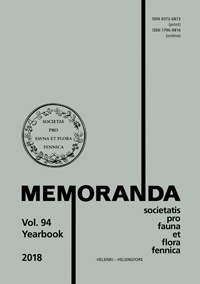What happens with the tree rings when the bird-cherry (Prunus padus L.) is defoliated by the moth bird-cherry ermine (Yponomeuta evonymellus Linnæus, 1758)?
Abstract
The anatomy of a Prunus padus tree which was totally defoliated by the moth bird-cherry ermine Yponomeuta evonymellus in 2013, was compared with a tree without the moth infestation. After been defoliated by Y. evonymellus larvae, the infested P. padus developed new leaves from the next year’s winter buds. These leaves grew so close to one another that they formed almost a leaf rosette. Consequently, the internodia of the branches were very short forming vegetative dwarf branches. In the normally developed tree, the leaves were located about 2 cm from one another on the branches.
The secondary xylem of Prunus padus is diffuse-porous or weakly ring-porous with the large vessels spread almost evenly throughout the tree ring or located together in irregular groups. The majority of the cells are lignified fibres. As a result of the infestation, the tree ring became narrower and the fibres in the middle part of the tree ring were not lignified properly. In the wood formed late during the season or in the tree ring formed during the following year the cell walls were lignified and thicker. Although this study includes only one studied infested P. padus tree, the effects of the infestation and defoliation is clear, and can be traced both in the morphology and the wood structure of the stem




